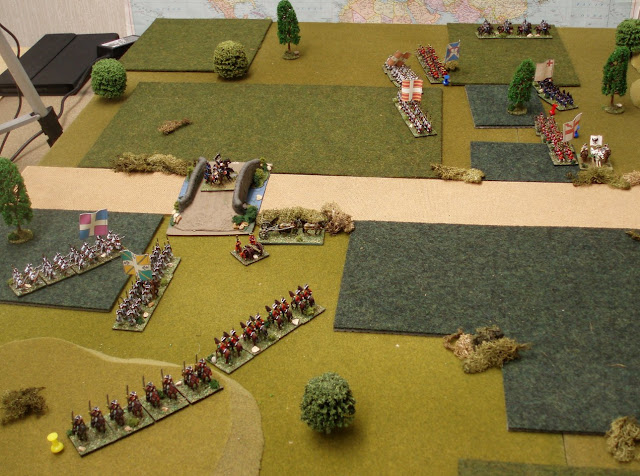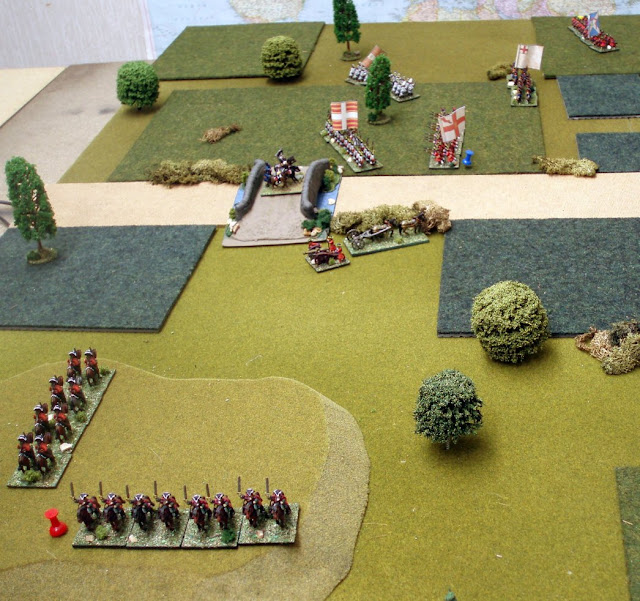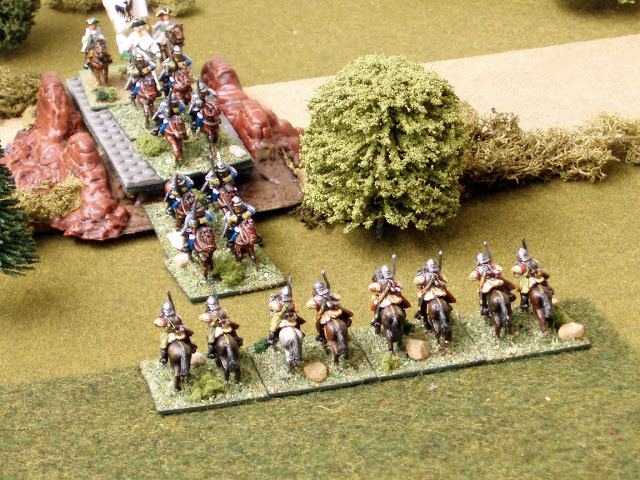...and so on with the game, which this time featured the second/updated version of DG's variant of my War of the Spanish Succession variant, of Will McNally's (excellent) Seven Years War rules which we last used in scenario #2...
Variant of a variant,egad... doesn't get much more Old School than that!

DG and I date back to the days when gamers used to make their own terrain, mould and cast their own soldiers, and write their own rules, simply because the breadth of choice available today was but a dim and distant twinkle back then... I think it fair to say that DG is more of a rules tinkerer than I am, once I have a set (and although I'm on version 9 of my WSS variant they've been unchanged in 14 months now*) I'm fairly conservative, but DG is always looking at mechanisms and trying new one's.. the rules used for this game featured average dice (to iron out some wild variations in result from the game using the first version), but also some new thoughts on morale recovery (which I think it fair to say I didn't like so much..

)
* though as a result of this game I think v10 will be on the way..more anon...
Either way, on with the game, and as a reminder, the table was as follows - starting edges top (DG) and bottom (me):
The game posed some interesting tactical questions for me (and I hope DG!

) - the objective was to capture both bridges but I had rolled a slow moving force comprising mostly infantry, some artillery (which I'd have swapped for a squadron of cavalry like a shot) and in terms of gaining the objective(s) quickly, just the one squadron of cavalry to leap forward and seize the bridge (and even they were slower heavies).
I knew DG's force on the other hand was cavalry heavy - 3 squadrons - so my plan then, was to focus entirely on one bridge (I chose the left one in the picture above), secure it, and then try and wrestle the other one away afterwards... We only had 15 moves to do this, but given we started the game off table, and I didn't know where DG was going to arrive on his edge, all in all it made for some enjoyable mental tussles on the bike ride to and from work..
The Game:
"The day dawned, only the squeal of axles, and the lowing of cows breaking the peace.. supplies destined to feed the insatiable war machine of M'lord The Duke of Marlborough"...
"Suddenly - more insistent sounds can be heard, the jingle of multiple harnesses, and the tramp of marching feet"... OK, enough of the cod fiction already..

The following is key as it shows the overall approach the two of us had taken..
As above I (bottom edge) had concentrated all of my troops to take the left hand bridge.. cavalry and one infantry battalion on the left of the hill, three further battalions of infantry and the artillery on the right/this side of it,.. DG had split his force along infantry and cavalry lines sending his cavalry to the right bridge and his infantry too the one I had in mind.. interesting!
Next picture - five or six moves later (may be more - apologies - exciting game and I forgot to stop and take pictures!) and DG had completed his cavalry envelopment, two of my infantry battalions were across the bridge and engaging DG's three. The interesting action however was on 'this side' of the bridge where my other two battalions and the deployed artillery were trying to stop his cavalry.. Off picture (to the right), I had had early success with the artillery and DG's heavy cavalry were routing..
A closer view of the picture will show that yet again I had made a schoolboy error and Bourbonnais (blue/purple quadrants), who I had about turned so as to make some space behind Toulouse, had been caught in the flank by DG's cavalry.
Next picture - amazingly however they held (!). On the other side of the river, however, disciplined crashing volleys, and steady advances, were delaying and pushing back DG's heavier force (ie. my dice were slightly better..

). The key however, is right in the distance at the top of the table, where my heavy cavalry can be seen beetling to the right behind his infantry - I'd had an idea..
 |
| Blue pin disordered, yellow pin shaken, red pin routing... |
His cavalry recovered though and a few shock moves later- both of my infantry battalions had routed, and in both cases this had taken them off the table.. only the artillery left this side, but I had started withdrawing Bearn to the bridge to assist... things were not looking good when in the dying moments of the game, the artillery saw off his cavalry...

Whilst on the other side, having noticed the bridge was un-held I had my cavalry over the bridge, and the game was mine by the skin of my teeth..!
 |
| Huzzah!! |
Talk about leaving it to the last moment!!
Post Match Analysis:
- First the butchers bill... DG's game easily by those scores 10 vs 5... trifle discombobulating to have two of your infantry regiments leg it off the table..!


- Quite a long game, the average dice worked in ironing out the big variations, but resulted in units lasting much longer than they would normally - this was not a one hour wargame..

- I had some problems with the new version of the rules, and as is the nature of things DG and I have discussed since the game...
- morale recovery; the game turn is A move/B fire/A melee/B move/A fire/B melee, with morale recovery being done in the movement phase for the relevant player - in the original rules morale checks from the melee aren't tested until the move after, but DG had gone for immediate testing, and this meant that the moving player could move into melee, cause the enemy unit to fail morale and scarper, but see that unit immediately recover and advance upon them in the next movement phase..
- cavalry vs infantry: seemed a bit powerful to me.. I've done some research this week (Chandler/Falkner/web etc) and forwarded it to DG, but as a result I will also update my rules to make frontal attacks by cavalry on steady infantry slightly less optimal
- manoeuvre: formation changes, and movement options seemed a little fast; armies at this time weren't as slow as say an English Civil War era army, but neither were they as quick in their drill as a Seven Years War/Napoleonic army... more research is required here, and I am delving into my usual sources, but comments would be appreciated.. I'm interested in sources that would give some insight into the infantry/cavalry ability to advance obliquely, ability to wheel; and for infantry, how common it was for them to go into square (I'm aware of the attempt by Rowse's at Blenheim)
Excellent.. as a result of this game I've just bought
this book [clicky] (NB. It's cheaper on eBay

) so that's no bad thing!
 )
)













